386 Search Results for complex communication
May 20, 2013
by Carole Zangari -
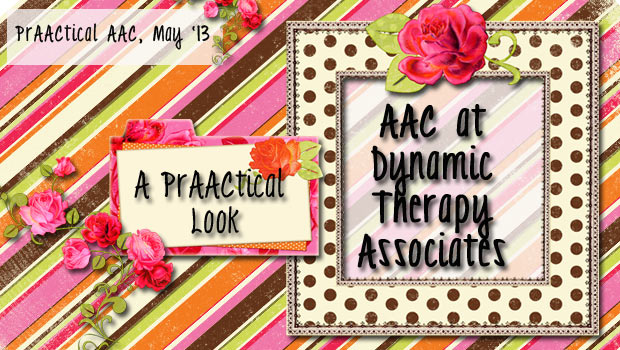
We’re so excited to continue our PrAACtical Look series with a guest post from Vicki Clarke, who is the CEO of Dynamic Therapy Associates, a speech language therapy clinic in Kennesaw, Georgia. Vicki specializes in AAC, conducting local and national device evaluations, consultations, treatments and trainings for individuals, clinics, school systems and professional organizations and manufacturers. Vicki has a wealth of knowledge in the prAACtical aspect of AAC service provision and shares a tiny bit of that with us in this post about preparing clients who use AAC for medical encounters. :::::::::::::::::::::::::::::::::::::::::::::::::::::::::::::::::::::::::::::::::::::::::::::::::::: I was asked to contribute a “favorite therapy activity” kind of post to this blog a few months ago. Decisions, decisions, decisions….I love Arts & Crafts Therapy, Cooking Therapy, iPad Therapy, Shopping Therapy, and Hang-Around-And-Chat Therapy but what to share? I mulled it over and I decided on “Serious Medical Procedure Preparation Therapy.” Fun stuff, right?!!? We do a lot... [Read More...]
May 13, 2013
by Carole Zangari -
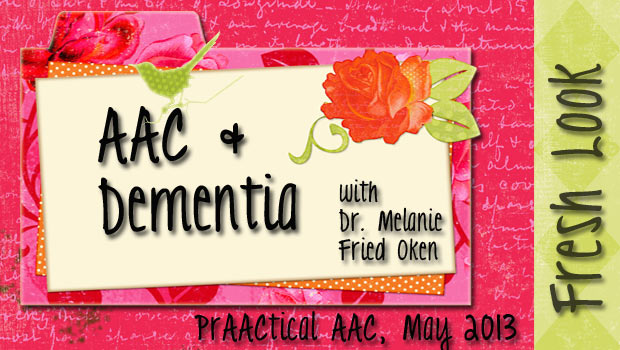
We’re thrilled to continue our Fresh Look series in celebration of Better Hearing and Speech Month (#BHSM). In this post, Dr. Melanie Fried Oken, from the Oregon Health and Science University, talks about some AAC strategies for people with dementia. I was captivated by her 2012 presentation on this topic at ISAAC 2012, and knew it was important to be able to share some of you work with you. We have much to offer these individuals with dementia, and Melanie’s post and linked resources are a great way to get started. ::::::::::::::::::::::::::::::::::::::::::::::::: Hey, what about us AAC providers who work with adults? We love reading PrAACtical AAC and can often adjust the tips, equipment recommendations, and strategies to meet our population needs. So when Carole gave me an opportunity to blog about AAC for adults with dementia, I grabbed the chance. I’d like to share with you some facts about... [Read More...]
April 19, 2013
by Carole Zangari -
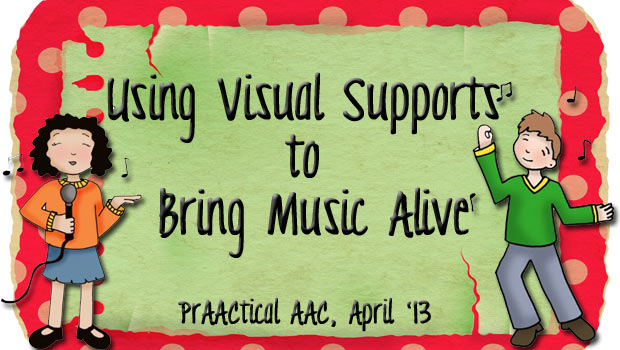
When I first met our guest blogger almost 20 years ago, she was using more visual supports in her music therapy sessions with kids who had ASD than most SLPs were using in their language therapy. Marlene Sotelo has worn many hats in her professional life, but her passion for helping people with ASD communicate more effectively seems to have permeated all of them. In this post, she discusses some of the ways she uses visual supports to help make music therapy effective. Music is a powerful force that transcends time, cultures, and languages. It can transport you to the past, and bring you hope and excitement for the future. In addition, music can be an effective tool in teaching children with varying abilities. The predictability, rhythmic patterns, and repetitive nature of the structure music lends itself to the development of language, cognitive skills, and motor skills, especially for individuals... [Read More...]
April 8, 2013
by Carole Zangari -
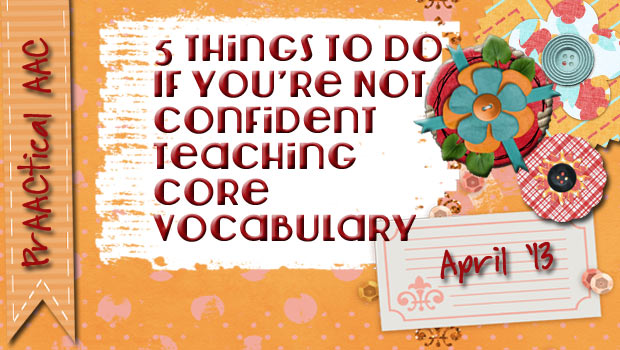
New to teaching core vocabulary in AAC? On board with the concept? Know that it’s important but find it a little intimidating to teach? Welcome to the club! Actually, it’s quite a big club but you wouldn’t know it because lots of members are still closeted. That’s okay – no one here is going to ‘out’ you. But if you want to move forward in your AAC teaching journey, here are some things to try. Breathe and forgive yourself: It’s easy to feel like everyone else knows this but you. Not true. We tend to beat ourselves up for not being out ahead of the curve, but you know what? It’s not worth it. We’re all a work in progress, so let it go and just start where you are. As one of our favorite eminent scholars** has repeatedly said, “When you know better, you do better.” Get your own... [Read More...]
April 4, 2013
by Carole Zangari -
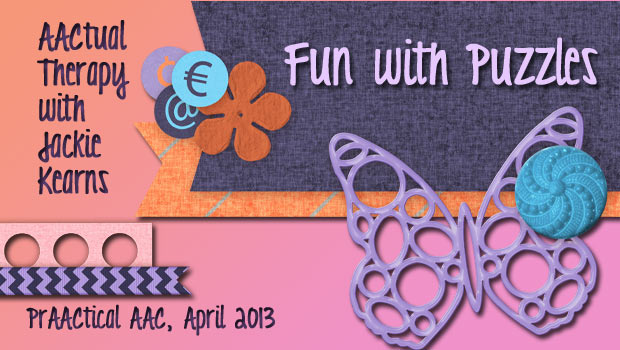
Today, we’re pleased to introduce SLP Jackie Kearns, coordinator of the Technology Resource Center at the Cleveland Clinic Children’s Hospital for Rehabilitation. Prior to that, she received her bachelor’s and master’s degrees from Ohio University. She completed both an undergraduate and graduate level thesis and has published in Contemporary Issues in Communication Sciences and Disorders. Jackie has over 5 years’ experience working with medically complex children in both inpatient and outpatient hospital settings. She has provided numerous AAC evaluations and treatment for children ranging from 1-21 years of age. In addition, she has done numerous presentations and in-services for staff at the Cleveland Clinic. We’re grateful to Jackie’s AAC professor and mentor, Dr. John McCarthy for recommending her to us. Therapy Activity: Fun with Puzzles Intended audience: Early intervention, preschool aged children, and/or emergent AAC communicators Type(s) of AAC: Eye gaze, reaching Picture communication symbols Single message voice output communication... [Read More...]
March 28, 2013
by Carole Zangari -
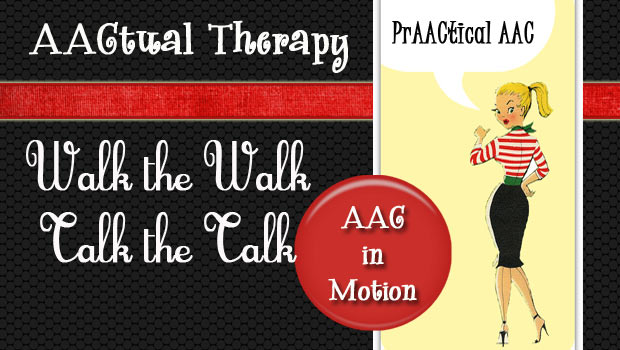
Tanna Neufeld hits another homerun with this post about co-treating children with multiple disabilities. Collaborating with our colleagues is both fun and challenging. Let’s take a look at the prAACtical ways that Tanna and her colleagues support kids with motor and visual impairments who are learning to use AAC. Fridays are my favorite. And not just for the obvious reasons (TGIF), but also because Fridays are one of the most challenging and exciting days of my work week. Every Friday, I am lucky enough to team with my favorite PTs for joint treatment sessions to support several children with multiple motor and communication challenges. Around our center, we lovingly refer to these kids as our “motor kids”. All of these little ones are nonverbal, and all have very complex motor challenges that significantly limit their ability to interact with traditional play and learning environments. Many of these kids also... [Read More...]
March 23, 2013
by Robin Parker -
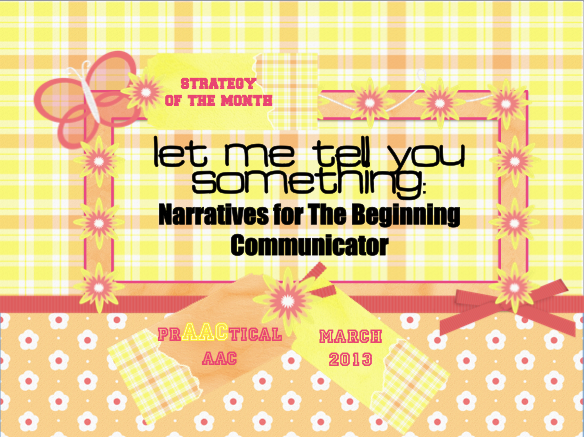
March continues with story telling or narratives as the Strategy of the Month. All learners have stories to tell but some may need special teaching to be able to express their stories. Goals for the beginning communicator can and should include narratives. Personal narratives are a good place to begin but any type of narrative can be taught with structure, routines, partner support, prAACtical strategies. Robust communication includes story telling. Yes, beginning communicators need to be able to express wants and needs however, authentic and comprehensive language involves much more. The quicker we start teaching, the quicker beginning communicators (or anyone) can learn. Beginning Communicator Narratives 3 Types (Just some of the options) Remnant Books are a visual and tactile way of telling stories by recording important events. Learners can help choose items from meaningful personal experiences which serve as a reminder of stories to tell. Create routines and visual supports... [Read More...]
March 16, 2013
by Carole Zangari -
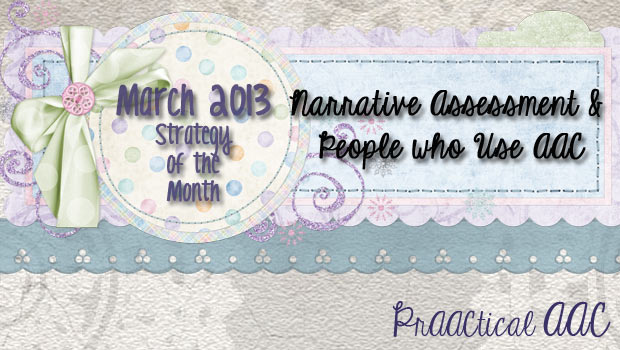
This month, we’ve been talking about building narrative skills in our AAC clients. We tried to build the case that including narrative language goals in our intervention allows us to help people who use AAC to participate more fully in social exchanges, relay more in-depth information, and achieve greater academic success. But how do we know where to start in narrative intervention? And how do we measure progress? In this post, we share some thoughts on the assessment of narrative language in AAC. Most test batteries that assess narrative language are designed to take a snapshot of what the learner has already mastered in terms of telling personal narratives, story retelling, or scripts. This allows us to look beyond MLU, morphology, and grammar and can be useful in determining whether intervention is needed. Some scholars, however, have noted the limitations of this “one shot” approach, particularly for learners whose communication... [Read More...]
March 13, 2013
by Robin Parker -

Saint Patrick’s Day is coming up. We love focusing on holidays in our sessions because it is a chance to teach new vocabulary and as importantly (if not more for some learners) it is a chance to teach social conversation about what many people in the community are talking about. Holiday’s also give us fun ways to focus on many other goals as well. The theme (in this case – a holiday) can serve as the platform for any goal that is appropriate. We just always ask ourselves (and our graduate students)- ‘What is the point’ or ‘What is the Goal’ when we have a great new themed activity. This is a time to work on core and fringe vocabulary, social conversation and interaction, play skills, and more. These are some fun activities matched to goals that we use to get ready for Saint Patrick’s Day. Surveys & or Questions–... [Read More...]
March 9, 2013
by Robin Parker -
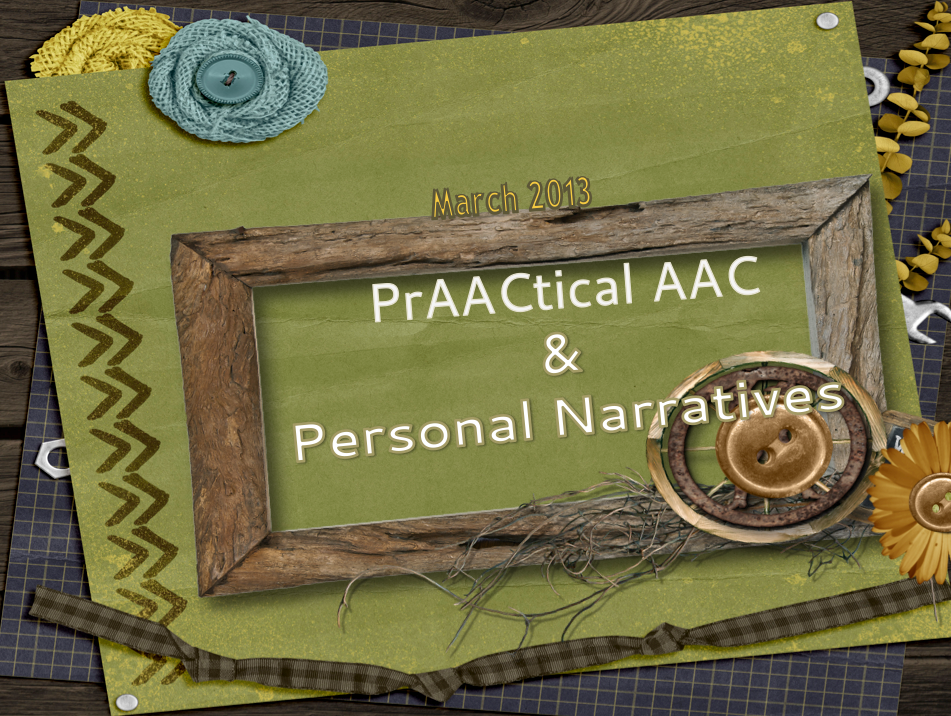
Personal narratives are the first story skills that develop. They tell about ourselves and our connection to activities, places, and events. They tell about how we feel about people and experiences. Personal narratives help us structure and organize the events of our lives and even become a way of thinking about ourselves and our identities. We know many AAC users have significant difficulty with narratives. We always wonder though, is it a function of language difficulty or of access, exposure, and PrAACtice or more likely a combination. There are key intervention strategies that help AAC learners be able to tell personal narratives. You probably won’t be surprised by what strategies work but the research from Gloria Soto and colleagues has shown us that when applied to personal narratives, AAC users can be competent story tellers. Some Thoughts on Personal Narrative Assessment Even before assessment of the AAC learner, in all fairness,... [Read More...]









